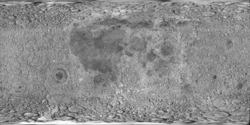Autolycus (kráter)
| Kráter Autolycus | |
|---|---|
 Autolycus | |
| Souřadnice na Měsíci | |
| Selenografická šířka | 30,7° S |
| Selenografická délka | 1,5° V |
| Další údaje | |
| Typ kráteru | impaktní kráter |
| Průměr kráteru | 39 km [1] |
| Hloubka | 3,4 km [1] |
| Colongitudo | 358° |
| Eponym | Autolykos z Pitane |


Autolycus je měsíční impaktní kráter nacházející se ve východní části Mare Imbrium (Moře dešťů) blízko nultého poledníku. Severně leží větší kráter Aristillus (průměr 55 km) a západně ještě větší kráter Archimedes (průměr 83 km). Část moře severozápadně od kráteru se nazývá Sinus Lunicus (Záliv Luny). Kráter Autolycus má průměr 39 kilometrů a je hluboký cca 3,4 km.[1] Pojmenován je podle řeckého astronoma a matematika Autolyka z Pitane.[1][2]
Jižně se rozkládá zvrásněný terén a za ním měsíční planina zvaná Palus Putredinis (Bažina hniloby). Východně začíná jižní okraj pohoří Montes Caucasus (Kavkaz) tvořícího předěl mezi Mare Imbrium a Mare Serenitatis (Moře jasu).
Luna 2
Do oblasti Mare Imbrium poblíž kráteru Autolycus (u jeho západního okraje) dopadla 13. září 1959 sovětská kosmická sonda Luna 2 (první sonda vyrobená člověkem, která dosáhla povrchu Měsíce).[1]
Satelitní krátery
V okolí kráteru se nachází několik sekundárních kráterů.[2] Ty byly označeny podle zavedených zvyklostí jménem hlavního kráteru a velkým písmenem abecedy.
| Autolycus | Sel. šířka | Sel. délka | Průměr |
|---|---|---|---|
| A | 30.9° S | 2.2° V | 4 km |
| K | 31.2° S | 5.4° V | 3 km |
Odkazy
Reference
Literatura
- RÜKL, Antonín. Atlas Měsíce. Praha: Aventinum, 1991. ISBN 80-85277-10-7.
Externí odkazy
 Obrázky, zvuky či videa k tématu Autolycus na Wikimedia Commons
Obrázky, zvuky či videa k tématu Autolycus na Wikimedia Commons - LAC 41, mapa 1:1 000 000 (Lambertova projekce)
- Autolycus Archivováno 12. 10. 2010 na Wayback Machine., Moon-wikispace.com (anglicky)
Média použitá na této stránce
Crater Autolycus with northern part of Montes Apenninus ans Apollo 15 landing site (detail of LRO - WAC global moon mosaic)
cylindrical map projection of the Moon. The Moon's whole surface was mapped by the Clementine spacecraft in 1994, here North is at the top. The dark floor of crater Plato is at the middle top above Mare Imbrium, while the bright floor and rays of crater Tycho is near the middle bottom below Mare Imbrium. Mare Procellarum is at the near left, and Mare Tranquillitatis is just right of centre and Mare Crisium is at the near right. The far left and far right show the contrast of the mostly cratered farside with small isolated mare.
Apollo 15 Hasselblad image from film magazine 96/Q - Lunar orbit, LM rendezvous. Autolycus crater.
Autor: M. Gålfalk, G. Olofsson, and H.-G. Florén; SIRCA camera, Licence: CC BY-SA 3.0
The Archimedes crater of the Moon and other features.
Archimedes is the largest crater near the center of the picture. It lies within the Mare Imbrium. The other large craters are Aristillus (to the right of Archimedes and higher, with pronounced central peak) and Autolycus (to the right and lower). At the lower right edge of the picture parts of the Montes Apenninus are visible.
Infrared image in L band centred on 3.75 micrometres. Taken with the SIRCA camera by M. Gålfalk, G. Olofsson, and H.-G. Florén. Nordic Optical Telescope, Stockholm Observatory. More images can be found here



